

Prusa Research - Prusa3D - 3D Printers from Josef Průša. Le Humanlab - My Human Kit. Nous avons décidé d’ouvrir en 2017 un « Humanlab », atelier pilote de fabrication numérique dédié à la santé pour tous qui essaimera sur tous les continents.

Le humanlab permettra l’auto-réparation, la réhabilitation des humains les uns avec les autres. L’objectif est ensuite d’essaimer ce modèle avec tous les lieux volontaires sur la planète, notamment les fablabs, pour constituer un réseau d’entraide et de prototypage international. La science n’est pas réservée aux scientifiques. Robotique, objets connectés, bio et nanotechnologies, chimie de synthèse...
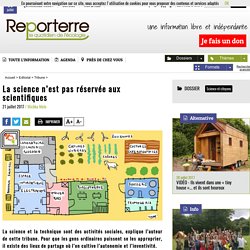
Parce que l’innovation est le principal moteur de la croissance qui dévore la planète, Reporterre publie une série de tribunes visant à démythifier le progrès et faire de la recherche scientifique un terrain de controverse et de luttes. Michka Melo est ingénieur, diplômé de l’École polytechnique de Lausanne et spécialiste de bio-ingénierie créative, notamment appliquée à l’écologie. « Le lieu vivant ». L’enseigne de cette bâtisse dont la porte est ouverte attire mon attention. Intrigué, j’entre. C’est un lieu dédié aux savoir-faire liés au monde vivant. J’y rencontre Ahmed, quinquagénaire jovial. « Ici, on développe de nouvelles techniques. À côté, Elina travaille avec des extraits d’épluchures de carotte. . « Mieux vaut prendre le temps de discuter, et que tout le monde se sente respecté » Dans la bibliothèque, une vingtaine de personnes sont assises en cercle. Les Makers m’écœurent - Le site du journal Le Postillon.
Lego-Like Chemistry and Biology Erector Set. A team of researchers and students at the University of California, Riverside has created a Lego-like system of blocks that enables users to custom build chemical and biological research instruments.

The system of 3D-printed blocks can create a variety of scientific tools. The blocks, which are called Multifluidic Evolutionary Components (MECs) appeared in the journal PLOS ONE. Each block in the system performs a basic lab instrument task (pumping fluids, making measurements or interfacing with a user, for example). Since the blocks are designed to work together, users can build apparatus — like bioreactors for making alternative fuels or acid-base titration tools for high school chemistry classes — rapidly and efficiently.
The blocks are especially well suited for resource-limited settings, where a library of blocks can create a variety of different research and diagnostic tools. Gallactronics: How to Make Oil From Plastic (theory) Among the many irremediable wounds that man is inflicting upon the environment, the improper disposal of waste plastic is growing into an alarming issue of concern.
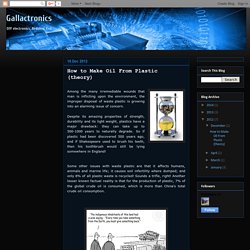
Despite its amazing properties of strength, durability and its light weight, plastics have a major drawback: they can take up to 500-1000 years to naturally degrade. So if plastic had been discovered 500 years ago, and if Shakespeare used to brush his teeth, then his toothbrush would still be lying somewhere in England! Some other issues with waste plastic are that it affects humans, animals and marine life; it causes soil infertility where dumped; and only 8% of all plastic waste is recycled! Sounds a trifle, right! Le Hackacon - 29 octobre 2016. Le concept vous semble familier ?
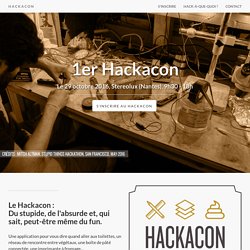
Le Hackacon est bel et bien un cousin lointain et illégitime des fabuleux Stupid Hackathons de New York et San Francisco. Pour l'édition du Hackacon, nous vous proposons les thèmes suivants : — La réalité virtuelle pour les animaux domestiques — Endettons nos enfants ! Pièces détachées électroménager : tous les sites. These DIY Eco-Friendly "Air Conditioners" Are Cooling Down Bangladesh. Out in the sticks of Bangladesh, the threat of flooding means that 70 percent of the population live in corrugated tin huts, most of which aren’t hooked up to an electricity supply.
In the heat of the summer, this can practically turn these houses into ovens. However, a project called Eco-Cooler is spreading knowledge of a cheap and electricity-free method to cool down houses throughout Bangladesh. The beauty of the project is it needs little more than a few plastic bottles and a board. It was started through a collaboration between advertising agency Grey Dhaka and Grameen Intel Social Business Ltd.
Here’s how it works: Plastic bottles are cut in half and then mounted into a grid through bottleneck-sized holes. Not only does it not require any electricity, it also makes good use of disposed plastic bottles. This $99 Gadget Turns Your Smartphone Into A 3D Printer. 3D printers have been set for big things for a long time.
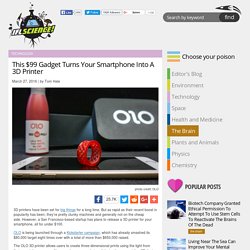
But as rapid as their recent boost in popularity has been, they’re pretty clunky machines and generally not on the cheap side. However, a San Francisco-based startup has plans to release a 3D printer for your smartphone, all for under $100. OLO is being launched through a Kickstarter campaign, which has already smashed its $80,000 target eight times over with a total of more than $650,000 raised. Google Cardboard. Un article de Wikipédia, l'encyclopédie libre.
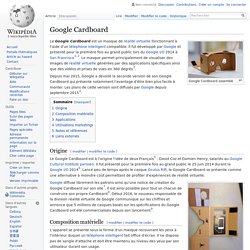
Google Cardboard assemblé. Here's How to Build a Home-Made Electric MotorVideo. Fully 3D Printed Working Engine Runs Completely on Hot and Cold Water — and You Can Print Your Own For Free. 3D printing is fascinating, especially to those individuals who have not ever seen the technology in action previously.

However, like with all new technology, this fascination subsides as time goes on and the technology becomes more commonplace. Perhaps we aren’t quite at this point yet with 3D printing, but the intrigue generated through the seeing, touching, and feeling of 3D printed objects will surely wither with time. One man in New Zealand, named Don Clucas, realizes this, and with the help of the University of Canterbury, he has come up with a way to fascinate even those already acclimated to 3D printing technology.
In a project that could be considered “breathtaking,” “innovative,” and “potentially revolutionary,” Clucas has created what he believes is the first ever fully 3D printed working engine. Better yet, it runs on thermodynamics, meaning all it requires for fuel is simple tap water. “There are many things that you can do with these engines,” explained Clucas. Turn your Smartphone into a 3D Hologram. Ma maison sur-mesure - Site de tinyhouse-baluchon ! Pourquoi j'ai monté ma boîte. Indiegogo. SATW_INFO_2-15_DIY-Bio_FR.pdf. Electronic Interfaces: Bridging the Physical and Digital Worlds.
How DIY neuroscience kits put research in the hands of the curious. Greg Gage left a career in engineering when he realized his real passion was for neuroscience.
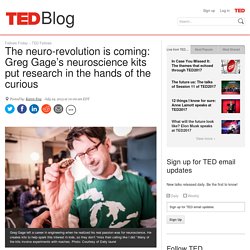
He creates kits to help spark this interest in kids, so they don’t “miss their calling like I did.” Many of the kits involve experiments with roaches. Photo: Courtesy of Daily laurel. Bricole It Yourself spécial canicule: fabriquer une clim en 15 minutes. Un ventilateur, c’est bien.
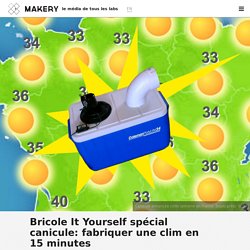
Loading... This tiny device creates a 3D map showing where your Wi-Fi sucks. The image above is not a computer rendering of the inside of an ant nest, but is instead a 3D map showing the strength of a Wi-Fi network at different points in a location. Using a Wi-Fi module, an LED, and a small battery pack, YouTube user CNLohr built a device that can measure the strength of a Wi-Fi network signal in all three dimensions and render out a color-coded map to show you where that network is strongest and weakest.
Here's what his device looks like: A handheld gadget to map Wi-Fi networks in 3-D space. CNLohr It's not much to look at, but it works well enough to effectively troubleshoot dodgy spots in one's own Wi-Fi network. Rejoignez le CUBE, tiers-lieu dédié à l’Agriculture Urbaine et à la résilience à Paris. La présence à Paris, notamment dans les arrondissements du nord-est, de nombreuses friches industrielles et de bâtiments désaffectés est à mettre en perspective avec le déficit de lieux d’expérimentation dédiés à l’agriculture urbaine et à la résilience dans la capitale. Saisissant l’opportunité du lancement du budget participatif et alors que la maire de Paris a annoncé vouloir faire de l’agriculture urbaine une des priorités de sa mandature, le collectif Babylone propose un projet à l’intersection des questions agricoles, alimentaires et sociales.
Son nom : le CUBE ! Arduino Vs. Raspberry Pi: Which Is The Right DIY Platform For You? If you’re at all familiar with do-it-yourself (DIY) electronics, you’ve probably heard about the comparable merits of Arduino and Raspberry Pi. You may have even, like I did, assumed they were competing hardware platforms solving similar problems. Thomas Thwaites: How I built a toaster. James Bond-Style Laser Watch Finally Invented. Aquaponie. Un article de Wikipédia, l'encyclopédie libre.
Système d'aquaponie réduit. Comment faire des graffitis en mousse: 6 étapes. Édité par WikiHow Traduction, Team FR Les graffiti en mousse, aussi appelés « écograffitis » ou « graffitis verts » remplacent la peinture en bombe, les marqueurs et autres substances chimiques généralement utilisées pour graffer. Ils utilisent à la place un pinceau normal et de la mousse qui pousse toute seule sur les murs.
Avec la montée des produits bios et écologiques, le graffiti a donc su séduire les artistes militants de tous bords. De plus, il peut aussi faire partie de la révolution du jardinage. Publicité Ingrédients Une ou deux touffes (environ une petite poignée) de mousse végétale2 tasses de babeurre vous pouvez aussi le remplacer par du yaourt NATURE (et non aromatisé)2 tasses d'eau1/2 cuillère à café de sucreDu sirop de maïs (facultatif) Étapes 1Récoltez autant de mousse que possible. Conseils. Littlebits.cc.
Ayah Bdeir: Building blocks that blink, beep and teach. L'après IKEA, c'est de construire ses meubles soi-même. “Trop cool ton meuble, tu l’as acheté où ??” “Laisse tomber, je ne l’ai pas acheté. Je l’ai fabriqué.” Le genre de répliques qu’on aimerait sortir plus souvent. Bonne nouvelle, fabriquer ses propres meubles est devenu hyper simple. Comme pour les meubles en kit : il suffit de suivre le mode d’emploi. Student Develops Inexpensive Solar Lens To Purify Polluted Water. Deshawn Henry, a Civil Engineering sophomore at the University of Buffalo, spent his summer developing a solar lens using inexpensive supplies from a hardware store that can clean 99.9% of pathogens in a liter of water in about an hour. The research project is practical and inexpensive, with the potential to be widely implemented and save lives. Over one billion people around the world lack consistent access to clean water, leading to the death of a child under the age of 5 every single minute.
Maker Faire, l’événement fondateur du do it yourself. Homemade Magneto Shoes Let This X-Men Fan Walk On The Ceiling. Make Your Own Droplet Microscope Lens for a Penny. Clear liquid droplets can bend light, acting like a lens. DIY sites.